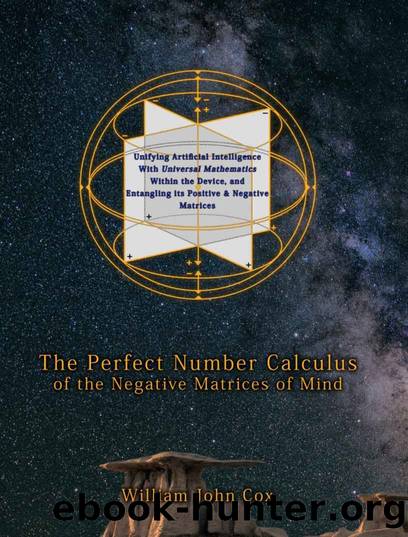The Perfect Number Calculus of the Negative Matrices of Mind by Cox William John

Author:Cox, William John
Language: eng
Format: epub
Published: 2022-03-13T00:00:00+00:00
Table U: The UN PerfectPrime Exponents of Two and Their
Perfect Logarithmic, Mersenne Prime, and Perfect Number
Progeny, With Ratio Proportions
When the Mersenne Prime produced by the PrimePerfect exponent 1W is divided by the exponent, the interesting proportion, U:210:NU2.0NU210 appears at the bottom of Table U. It displays the continuance of a recurring digital sequence across the decimal, and when divided by its own fraction, the near even result is N0.0006WX00.
Dividing the Mersenne Prime and perfect numbers by reduced .NU21 (the inverse counter of the 2bit .12UN) demonstrates the same curious result of numbers with recurring digits that leap past the decimal as their own fraction.
When the perfect number 1W(W) x 10W resulting from the PerfectPrime 13 and Mersenne Prime 6W:WWW is divided by .NU21 the result is: 3X0003X0003X0001W0001W0001W0001.W0001. One cannot imagine this amazing number and all the other UN numbers in the tables and matrices of this paper displayed sensibly in base 10. The finger ten translation of the logically self-organizing 3X000 ⦠.W0001 number produces the gibberish: 540096687853253110940016344513445134416897048577, although even there one can glimpse a momentary repeating pattern of 3445134451344 floating in the morass of unintelligible finger digits.
These âleapâ numbers continuing across their own decimal points began to appear as Table U was being calculated and may be only an interesting irrelevance. Thus, a last table with these tedious calculations is not included, although it does appear that the progeny numbers of the PerfectPrime superstructure may generate a symphony of their own visually interesting fractional languages within their relative proportions. The progressive complexity of these mathematically related fractions should meet and exceed the positive logarithmic powers of two, eternally and infinitely.
Because of this entanglement, UN geometry and numbers may be able to naturally incorporate and correlate interrelated matrices and functions, including existing Cartesian and polar coordinates (and the calculus of math and science using constant ratio numbers) allowing for an easier and more accurate positive-negative, probable-proximate, identification of accelerating moving points in space and time.
The UAI core of a computer programmed with the UN positive and negative basic and standard matrices, may instinctively and simultaneously âknowâ all âitsâ numbers and where they exist on all UN matrices uniquely in relation to all other numbers, and where the device itself exists in relative reality to the useful information acquired and accumulated by its UAI.
Each bit of computer data may be imagined as embodying all the complex proportions of one discussed thus far, with each bit having learned to demonstrate and communicate its unique information through the discrete values and color complexities of its composition. Each message includes its entangled answer, to be evaluated upon arrival as being proximate or notâand reflected. Is it or is it not the expected message?
By providing an instant second opinion to binary yes or no questions, the operation of simultaneous positive and negative calculating matricesâeach expandable from before infinity to beyond eternity and each capable of correcting the otherâmay help improve the transmission of information and the calculation, translation, and understanding of digital data.
Download
This site does not store any files on its server. We only index and link to content provided by other sites. Please contact the content providers to delete copyright contents if any and email us, we'll remove relevant links or contents immediately.
| Aeronautics & Astronautics | Astronomy |
| Astrophysics & Space Science | Comets, Meteors & Asteroids |
| Cosmology | Mars |
| Solar System | Star-Gazing |
| Telescopes | UFOs |
Tools of Titans by Timothy Ferriss(8225)
Turbulence by E. J. Noyes(7942)
Secrets of Antigravity Propulsion: Tesla, UFOs, and Classified Aerospace Technology by Ph.D. Paul A. Laviolette(5311)
Astrophysics for People in a Hurry by Neil DeGrasse Tyson(5134)
Room 212 by Kate Stewart(5041)
Design of Trajectory Optimization Approach for Space Maneuver Vehicle Skip Entry Problems by Runqi Chai & Al Savvaris & Antonios Tsourdos & Senchun Chai(5012)
Pale Blue Dot by Carl Sagan(4917)
The David Icke Guide to the Global Conspiracy (and how to end it) by David Icke(4629)
A Journey Through Divination and Astronomy by Publishing Pottermore(4344)
Goodbye Paradise(3729)
Apollo 8 by Jeffrey Kluger(3638)
COSMOS by Carl Sagan(3559)
Losing the Nobel Prize by Brian Keating(3499)
The Five People You Meet in Heaven by Mitch Albom(3476)
How to Read Water: Clues and Patterns from Puddles to the Sea (Natural Navigation) by Tristan Gooley(3410)
Brief Answers to the Big Questions by Stephen Hawking(3369)
How to Read Nature by Tristan Gooley(3251)
The Order of Time by Carlo Rovelli(3145)
A Brief History of Time by Stephen Hawking(2962)
